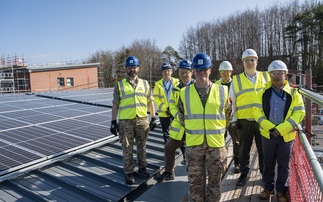Blackfriars station secures half its power from solar panels as pioneering solar roof comes online
After nearly five years in the making, Network Rail has today cut the ribbon on the world's largest solar-powered bridge at Blackfriars Bridge across the River Thames.
As part of a project with solar installation firm Solarcentury, the roof of the bridge has been covered with 4,400 photovoltaic panels, providing up to half of the energy for London Blackfriars station.
First Capital Connect, which runs Blackfriars, expects the panels to cut the stations' carbon emissions by an estimated 511 tonnes a year, further reducing the carbon footprint of its train routes to the south east of England.
"Electric trains are already the greenest form of public transport - this roof gives our passengers an even more sustainable journey," said David Statham, managing director of First Capital Connect. "The distinctive roof has also turned our station into an iconic landmark visible for miles along the River Thames."
The bridge will also act as a major advertisement for London's efforts to become a sustainable city, with tourists and workers viewing the panels as they enter the capital.
The project was one of the most complex to date for Solarcentury, which installed the panels in a series of phases over the past two years, pausing to minimise the impact on the station during the 2012 Olympic Games.
"We had different sections of roof available at different times to fit in with this complicated jigsaw of getting everything up and going," explained Gavin Roberts, Solarcentury's senior project manager, adding that the company had even considered shipping some of the components in via the Thames.
He added that as a city centre site Blackfriars presented a lot more challenges to a warehouse rooftop, such as transport restrictions and ensuring safety standards were followed while the station was still operating.
For such a large and complex project, Solarcentury said the key to success could be found in early planning and ensuring that the intergation of the panels is included during the design stage of the station's wider upgrade project.
"Solar is often seen as an afterthought, coming in at the end of a project," explained Suzanna Lashford, head of commercial sales for Solarcentury. "So having everything designed in as early as possible [meant that the project] would not only be quicker, but would also be cheaper.
"We did that very well at Blackfriars, but in future it is a must to ensure everything is kept to a cost minimum. Projects would then look much more viable for clients and we'll see more of them cropping up."
And while ministers warns of the risk of a potential backlash against "monster solar farms" on green belt land, Solarcentury maintains a solar bridge in the centre of London can have quite the opposite impact on the landscape and perception of renewable energy.
"The fact that it's so visual is a real bonus," said Lashford. "I think as a statement, London often tries to be a sustainable city and I think it's great from that point of view."
She now hopes the project will inspire more big infrastructure developers to embrace the benefits of renewable energy.
"Network Rail has invested funds into the project is a great sign for the solar industry," she said. "They're an old English institution and they're looking to the future to make investments into non-core technologies for the business, and that's a great statement that other large corporations in the country can start realising."









